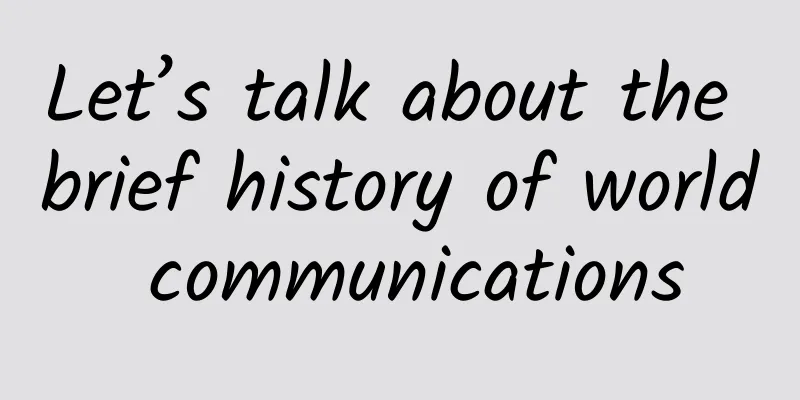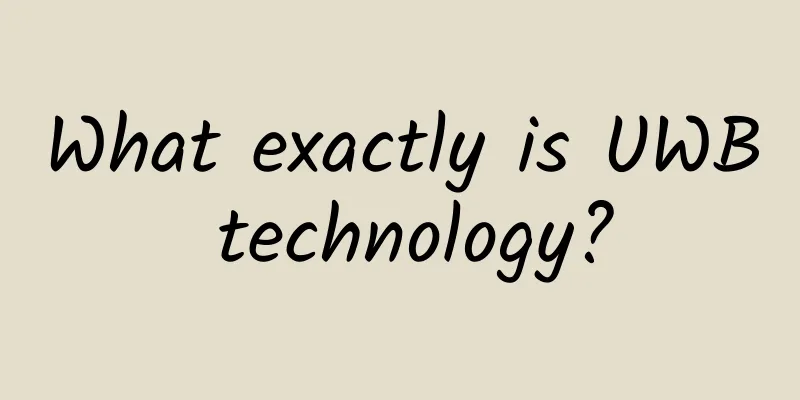Let’s talk about the brief history of world communications

|
This article is reprinted from the WeChat public account "Xianzao Classroom", the author is Xiaozaojun. Please contact the WeChat public account of Xianzao Classroom to reprint this article. The embryonic stage: the birth of modern communicationsAround 600 BC, the ancient Greek philosopher Thales was bored and rubbed a kitten with an amber stick at home. As he rubbed, he found that the amber stick sucked up the kitten's hair. Now we all know that this is due to static electricity, but people at that time (including Thales) did not know it. Thales believed that this was the same principle as magnets, and he called this unknown mysterious force "electricity." In fact, human civilization's record of "electricity" can be traced back to an earlier time. In ancient Egyptian books written in 2750 BC, people recorded a creature called electric fish (actually electric rays), which was called "the thunder messenger of the Nile River." Neither the ancient Egyptians nor the ancient Greeks would have imagined that "electricity" would completely change the fate of mankind thousands of years later. In 1600, William Gilbert, a British physician to Queen Elizabeth I, used the Latin word "electricity" to describe the force exerted by certain substances when they rub against each other. He also wrote a famous book, On Magnetism. In the book, he believed that the generation of electricity requires friction, while magnets do not, so electricity and magnetism are two different things. This idea persisted for many years, and people continued to study electricity and magnetism separately as unrelated disciplines. Later, more and more people began to study electricity and made great progress. The greatest discovery was Benjamin Franklin's "kite experiment". Kite experiment - Franklin released a kite with a key tied to it into the clouds with a metal string. Lightning struck the key and was felt by Franklin's hand along the metal string. In 1820, Dane Hans Christian Oersted discovered the magnetic effect of electric current, re-establishing the connection between electricity and magnetism. In 1821, Englishman Michael Faraday invented the electric motor. Ten years later, in 1831, he discovered the law of electromagnetic induction and built the world's first generator that could generate continuous current. Faraday Great times give rise to great inventions. In 1837, American Morse invented Morse code and the wired telegraph. Morse and his telegraph The emergence of the wired telegraph is of epoch-making significance - it allows humans to obtain a completely new way of transmitting information, which is "invisible", "intangible" and "inaudible", and completely different from previous letters, flag signals, trumpets and beacons. In 1865, the British James Clerk Maxwell proposed the Maxwell equations, established classical electrodynamics, and predicted the existence of electromagnetic waves. In 1876, American Alexander Bell applied for a patent for the telephone and became the father of the telephone. Although the real father of the telephone should be Antonio Meucci, he was too poor to apply for a patent, so Bell took over. In 1888, German Heinrich Rudolf Hertz proved the existence of electromagnetic waves through experiments. Thus, the edifice of classical electromagnetic theory was officially completed. In 1896, Italian Guglielmo Marchese Marconi achieved the first radio communication in human history, with a communication distance of 30 meters (reached 2 miles the following year). Guglielmo Marconi - the father of radio From this moment on, mankind officially opened the door to the wireless communication era. Dormant period: waiting, patiently waitingFor a long time thereafter, wired communications and wireless communications developed on their own tracks and did not get very close to each other. Let’s look at wired communications first. After the invention of the telephone, people's voices could be transmitted on wires. In fact, sound signals are converted into electrical signals, which are transmitted through wires and finally converted back into sound signals. For communication networks, the main problem to be solved is how to lay and connect these wires. In the beginning, manual switches were used for connection. Operators and switchboards As the number of users increased, the telephone network became larger and larger, with the number of telephone lines increasing from hundreds to thousands and then tens of thousands. Telephone poles from the late 19th century with thousands of telephone wires on them In this case, manual switches are obviously no longer able to meet the needs. In addition to the unbearable workload, the error rate is also very high. In 1891, a funeral home owner named Shi Duanqiao suffered a huge loss due to the manual switching system. AB Strowger, Almon Brown Strowger He found that the business calls to his store were always transferred to another funeral home by the operator. Later he found out that the local operator was the cousin of the owner of that funeral home. So he was very angry and vowed to invent a switch that did not require manual operation. As a result, he actually did it. He built the world's first stepping telephone switch in his garage. In his honor, this switch is also called "Stefanie Switch". This is a mechanical switch, bearing the imprint of the mechanical industrial era. Although it has achieved the replacement of manual labor, it still has many disadvantages, such as sliding contacts, poor reliability, easy damage, slow movement, complex structure, and large size. In 1919, Swedish engineers Bertaland and Palmgren jointly invented a new type of selector called "vertical and horizontal connector" and applied for a patent for it. Crossbar This type of connector changes the previous sliding type to a point-contact type, thereby reducing wear and tear and increasing service life. Based on the "vertical and horizontal connector", the world's first large-scale vertical and horizontal automatic telephone exchange was put into use in Sundsvall, Sweden in 1926. In 1938, the United States opened the No. 1 vertical and horizontal automatic telephone exchange system. Soon after, countries such as France and Japan also produced and used such systems. From then on, mankind officially entered the era of vertical and horizontal switches. By the 1950s, the vertical and horizontal switching system had become very mature and complete. Crossbar Switch Both the "vertical and horizontal system" and the "stepping system" use electromagnetic mechanical action to connect wires, so they both belong to the "electromechanical automatic telephone exchange". Machines are machines after all, with low efficiency, small capacity, and high failure rate, which can hardly meet the growing communication needs of human beings. Therefore, people are looking forward to the emergence of a new exchange processing method. In December 1947, a research team consisting of Shockley, Bardeen and Brattain at Bell Laboratories in the United States invented the transistor. The world's first transistor The birth of the transistor set off a wave of microelectronics revolution and also sounded the clarion call for the subsequent birth of integrated circuits. With the rapid development of semiconductor technology and electronic technology, people began to consider introducing electronic technology into telephone exchanges. Since the performance of electronic components at that time could not meet the requirements, a switch technology combining electronics and traditional mechanics emerged, which was called a "semi-electronic switch" or "quasi-electronic switch". Later, microelectronics technology and digital circuit technology developed further and matured, and finally the "all-electronic switch" came into being. In 1965, Bell successfully produced the world's first commercial stored program control switch (also known as "program-controlled switch"), model No.1 ESS (Electronic Switching System) No.1 ESS program-controlled exchange In 1970, France opened the world's first program-controlled digital switching system E10 in Lannion, marking the beginning of a new era of digital switching for mankind. The essence of a programmable switching system is a switch controlled by an electronic computer. NEC program-controlled switch It uses a pre-programmed program to control the connection action of the switch, and its advantages are very obvious: fast connection speed, multiple functions, high efficiency, clear sound, reliable quality and large capacity. Before we enter the 1980s, let's pause for a moment and look back at the development of wireless communications. For a long time after Marconi invented the wireless telegraph, wireless communications were in the state of one-way communication (simplex communication). Simplex communication, only one-way communication That is to say, the sender sends information and the receiver receives information in a one-to-many manner. Anyone can receive the radio waves sent by the sender, and only those who have the code book can decrypt the content of the radio waves. If it is an unencrypted plaintext radio wave, anyone can know the content of the message. Radio is such a "one-to-many" simplex working mode. After the emergence of radio, it replaced newspapers to a certain extent and became the fastest way for people (rich people) to obtain news. The world's first radio station War is a catalyst for high-tech, and so is communications technology. During World War II, Motorola (founded in 1928) developed a groundbreaking product - the SCR-300 military walkie-talkie, which enabled long-distance wireless communication up to 12.9 kilometers. The SCR-300 uses FM frequency modulation technology, which has certain anti-interference capabilities and stable signal quality, but it is also heavy (16 kg) and needs to be carried by a dedicated communications soldier or installed in a car or airplane. In 1946, Bell Labs created the world's first so-called "mobile phone" based on a field walkie-talkie. However, although it was called a mobile phone, it was very large, so the researchers could only put it on a shelf in the laboratory, and soon it was forgotten. Subsequent communication technology, like the previous wired communication, has been limited by the technical bottleneck of electronic components and has not made any major breakthroughs. Also, as semiconductor technology gradually matured, wireless communication equipment began to have a foundation for rapid development. In 1958, Soviet engineer Leonid Kupriyanovich invented the ЛК-1 mobile phone, which could only be used when installed in a car. Leonid Kupriyanovich is testing the LM-1 portable mobile phone (Source: Soviet magazine "Zarulem", issue 12, 1957) In the 1960s, technology companies, such as Motorola and AT&T, began to regain interest in developing mobile phones. Entering the 1970s, wireless communication technology finally saw an explosion. One day in April 1973, a man stood on the street in New York, took out a device about the size of two bricks, and spoke to it. He danced with excitement, attracting the attention of passers-by. This person is the inventor of the mobile phone, Martin Cooper, an engineer at Motorola. Martin Cooper and his invention of the mobile phone The first mobile phone call in the world was made to a rival of Martin Cooper who worked at Bell Labs. The rival was also developing mobile phones at the time, but had not yet succeeded. Cooper later recalled: "I called him and said, 'Joe, I'm talking to you now on a portable cellular phone.' I heard 'gnashing of teeth' on the other end of the receiver - although he had been quite polite." The mobile phone invented by Martin Cooper was the world's first true mobile phone, which could be carried by one person and used for conversations while on the move. The invention of the mobile phone marked the beginning of the era of universal communications for mankind, and also marked the beginning of wireless communications surpassing wired communications. Explosive period: From 1G to 4G, the rise of mobile communicationsThe beginning of mobile communications is naturally called the 1G era. The company that dominated the 1G era was Motorola. The symbol of the 1G era was the brick-like mobile phone. After 1980, mobile phones gradually entered people's lives and people began to use them for long-distance communication. 1G uses analog communication technology, which has poor confidentiality, low capacity, poor call quality and unstable signals. In the late 1980s, with the increasing maturity of large-scale integrated circuits, microprocessors and digital signal technology, people began to study the transformation from analog communication to digital communication. So, soon, we ushered in the 2G era. 2G was the debut of digital mobile communication technology. In the early days, in order to get rid of the situation in which the communication standards of the 1G era were monopolized by the United States, Europe planned to develop its own communication standards. Therefore, in 1982, the European Postal and Telecommunications Administration established the "Mobile Expert Group" to be responsible for the research of communication standards. This "Mobile Experts Group" has the French abbreviation Groupe Spécial Mobile. Later, the meaning of this abbreviation was changed to "Global System for Mobile communications", which is the famous GSM. The core technology of 1G is FDMA (Frequency Division Multiple Access). As the name implies, different users use channels of different frequencies to achieve communication. The core of 2G GSM is TDMA (Time Division Multiple Access), which divides a channel equally among eight callers, allowing only one person to speak at a time and each person taking turns to use 1/8 of the channel time. Unexpectedly, the American company Qualcomm has developed a third system, which is CDMA. The core of CDMA is code division multiple access. Compared with GSM, CDMA has larger capacity, better anti-interference and higher security. However, CDMA started late, and GSM has already occupied most of the global market share and has become the de facto global mainstream standard. In addition, using Qualcomm's CDMA requires paying huge patent licensing fees. Therefore, although both are 2G standards, CDMA's influence and market size cannot be compared with GSM. The "Patent Wall" at Qualcomm's headquarters During this period before the rise of 2G, another important thing happened, which was the explosion of the Internet. In the 1980s, as computer technology became increasingly mature, computer network technology also developed rapidly, the relevant basic theories were gradually improved, and eventually gave birth to the powerful Internet. After the rise of the Internet, the demand for data communication between computers has exploded. Before this, the main content of people's communication was voice. Now, people have to start thinking about how to transmit computer data messages. These data messages are the carriers of images, audio, video and other files. Transmitting data messages is also called "packet switching service". In contrast, telephone calls belong to "circuit switching service". The direct consequence of the rapid growth of packet switching services is the huge impact on channel capacity. As we mentioned earlier, in the 1970s, wired communications developed into program-controlled switching. To put it bluntly, program-controlled switching is still a circuit switch that is mainly used for voice services. The carrier mode is also mainly TDM circuits (just think of it as cables), which cannot meet the needs of packet switching services. Therefore, Ethernet and network cables were introduced. Network cables are the most suitable transmission medium for transmitting IP packets. The left is an E1 cable (a type of copper core cable), and the right is a network cable (twisted pair) The transmission media has changed, so of course the transmission equipment and switching equipment must also change. Therefore, in the 1980s and 1990s, transmission equipment evolved from PDH/SDH to MSTP and PTN, and switching equipment evolved from program-controlled switching to NGN (next generation network) and soft switching. It doesn’t matter if you don’t understand. Just remember that during this period, the key development direction of communication technology was from analog to digital, from circuits to IP, and from voice to multimedia. The main pain points for operators at this stage are still the insufficient capacity of the communication system and the high price of communication equipment. Such high costs are also passed on to ordinary users, resulting in the consumption level of communication products still being high and unable to be fully popularized. However, the price barrier is being broken, and more and more people are able to afford landline phones and dial-up Internet access. Let’s get back to mobile communications. After the introduction of 2G mobile phones, more and more users could afford mobile phones, and their needs expanded from being able to make calls to being able to access the Internet. In order to access the Internet and to provide support for packet data services, 2.5G, namely GPRS, General Packet Radio Service, has evolved. The Internet access speed of GPRS is very low, only 115Kbps, which obviously cannot meet the needs of users. Therefore, in order to achieve faster Internet speed, communication manufacturers began to launch 3G technology. The three major 3G standards are WCDMA led by Europe, CDMA2000 led by the United States, and TD-SCDMA launched by China. As the names suggest, the three major technologies are closely related to CDMA, which also makes Qualcomm earn a lot of money. The speed of 3G network has been greatly improved compared with 2.5G, reaching 14.4Mbps (theoretical downlink speed of WCDMA), which can already meet the basic multimedia service needs. At the same time, Apple's Steve Jobs launched the iPhone at the right time. Smart phones represented by the iPhone have completely changed our lives. Steve Jobs and the iPhone After that, it was 4G LTE. I believe everyone is very familiar with the story of this stage. From 1G to 4G, from the user's perspective, 1G brought about mobile calls, 2G popularized mobile calls, 2.5G realized mobile Internet access, 3G realized faster Internet access, and 4G realized even faster Internet access and basically met all of people's Internet needs. From the perspective of operators and mobile communication networks themselves, the transition from 1G to 4G is a transition from analog to digital, from frequency division to time division to code division to integration, from low frequency to high frequency, and from low speed to high speed. The capacity of the system is constantly increasing, and the security and stability are also constantly improving, while the cost is constantly decreasing. Ultimately, communication has changed from a privilege for a few to a benefit for everyone. The same is true for the development of wired communications. I almost forgot to mention that there is another major invention that has greatly alleviated the capacity bottleneck of the communication system, and that is optical fiber. In 1966, Chinese-American scientist Charles Kao pioneered the idea that optical fibers could be used in communications, thus opening the door to the world of optical communications. Charles Kao (November 4, 1933 - September 23, 2018) Over the past few decades, optical fiber has become an irreplaceable and important component of the communication system with its ultra-high capacity and ultra-low cost, and has also brought about earth-shaking changes in our lives. If it were not for optical fiber, we would not have such a fast Internet speed now, and there would be no so-called mobile Internet life. So far, thanks to the efforts of countless communications people, we have achieved remarkable results in the communications field. With advanced communications technology and developed communications networks, we provide support for global social and economic development. Looking to the future: Where is communications headed?Human progress will not stop, and neither will the development and evolution of communication technology. Today, we are once again standing at a turning point in the times. On the surface, this is the turning point between 4G and 5G, and we are entering the exciting 5G era. But in the true sense, now is the turning point between the era of human Internet and the era of Internet of Things. Our goal is the vast ocean of stars where all things are connected. Will the future really be as exciting as imagined? Will IoT applications usher in a second golden age? No one knows the answer. All we can do now is to work hard and wait patiently. However, with the communication technologies and networks we have now, there are really not many areas in which we can work towards. The main focus of wireless communications is still the bandwidth of the wireless air interface. 5G's Massive MIMO enhanced antenna array, beamforming, and stronger coding methods will further squeeze out the potential of electromagnetic waves. As for wired communications, optical fiber seems to be able to meet bandwidth requirements (currently optical fiber has reached Pb/s level, 1Pb=1024Tb), and there is no technical bottleneck in the processing capacity of switching equipment. The main focus at present is how to achieve lower costs, higher flexibility, scalability and security, and how to find the perfect balance between performance, demand and cost. The introduction of AI and the maturity of cloud computing and big data technologies are likely to assist in the next upgrade of communication systems and help achieve the above goals. In short, electromagnetism, as the theoretical foundation of modern communication technology, has a history of more than 130 years. It has been more than 70 years since Mr. Shannon, the founder of the field, proposed the Shannon formula. With the help of countless communication people, we are approaching the limit. I believe that in the near future, there will be great scientists who will break through the dome and bring the dawn of a new world. As a communications person, I look forward to this day coming soon. References: 1. "Big Talk on Mobile Communications" - Zhang Haijun et al. 2. "The Way of Communication, from Calculus to 5G" - Yang Xuezhi 3. From 1G to 5G, a review of the magnificent evolution of mobile networks - Network Optimization Mercenaries 4. Martin Cooper entry, Baidu Encyclopedia |
<<: The impact of 5G on enterprises
Recommend
Top 10 economic predictions for the tech industry in 2024
As we stand on the cusp of a new year, the tech i...
The convergence of edge data centers and 5G revolutionizes data transmission and the Internet of Things
With the rapid development of the digital age, th...
The basics of the commonly used mainstream dynamic routing protocol OSPF and OSPF message types. Learn about them in one minute
1. Basic Concepts of OSPF OSPF is based on IP pro...
[11.11] Megalayer: US server 99 yuan/month, Hong Kong server 199 yuan/month, Hong Kong/US VPS monthly payment 9.9 yuan
Megalayer released a promotional plan for this ye...
6G Internet of Things: From the Internet of Everything to the Intelligent Internet of Everything, opening up smart life, smart production and smart society
At the 6G Internet of Things Forum of the 4th Chi...
Traditional switches are difficult to match the Internet of Everything, Aruba CX next-generation switching platform is re-installed
[51CTO.com original article] On December 18, 2019...
Huawei's Yu Chengdong: This is a truly global mobile Internet cloud service
Normal 0 7.8 磅 0 2 false false false EN-US ZH-CN ...
my country started IPv6 construction early but is still late. How will we roll up our sleeves and work hard in 2017?
As early as 2003, my country put the development ...
Edge computing vs. cloud computing: Which is more efficient?
Cloud computing provides businesses with the oppo...
HTTP/3 is here! The TCP protocol that has existed for more than 20 years is finally abandoned!
On June 6, Robin Marx, a member of the IETF QUIC ...
The decline in operators' ability to generate revenue will affect the rapid deployment of 5G
The report on the economic operation of the commu...
5 Essential Predictions for Blockchain Trends in 2018
The potential for blockchain technology to bring ...
[Double Holiday] DesiVPS: $15/year-1GB/15G NVMe/1.5TB@10Gbps/San Jose Data Center
DesiVPS released a Christmas promotion plan, whic...
How to design network architecture to make IoT devices safe and reliable?
[51CTO.com Quick Translation] While the Internet ...
The turning point has arrived: NB-IoT industry is accelerating its release!
The birth of any new technology is always met wit...









